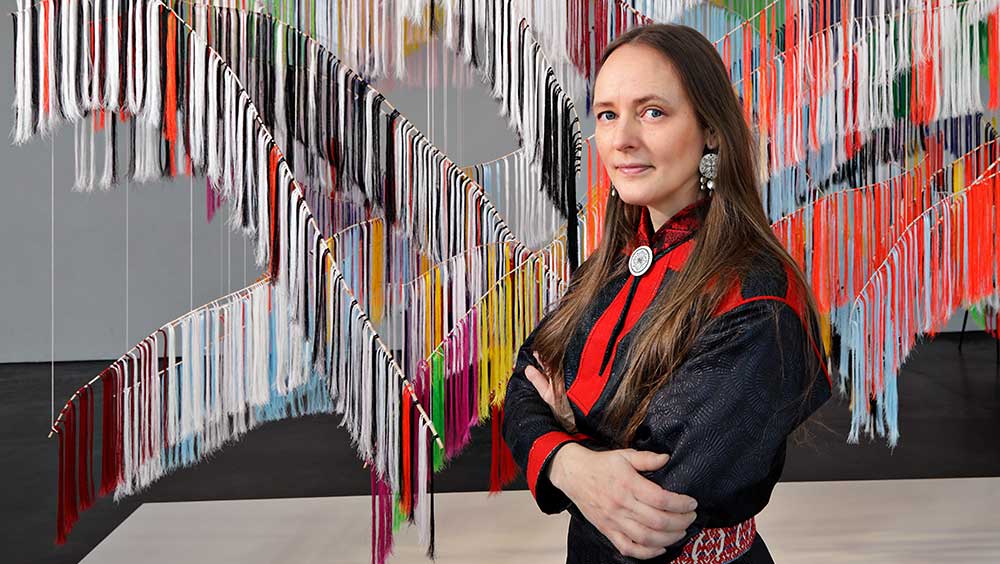
Outi Pieski. Photo: Heikki Tuuli.
by VERONICA SIMPSON
“Rituals are processes of embodiment and bodily performances. In them, the valid order and values of a community are physically experienced and solidified.” This is one of the many nuggets of wisdom from Byung-Chul Han’s The Disappearance of Rituals, a slender but profound book that is required reading for those concerned by our fragmenting and eroded social and natural landscapes. The work of Sámi artist Outi Pieski (b1973, Helsinki) has evolved out of ritual and embodied knowledge of the landscapes of the Sápmi region, which includes northernmost Finland, the northern parts of Norway and Sweden, and Russia’s Kola Peninsula. The indigenous beliefs and practices of the Sámi people – that we are not separate from nature, that interconnectivity and reciprocity is the way to inhabit the world harmoniously – underpin her philosophy and her art.
In the first major UK retrospective of Pieski’s work, at Tate St Ives, the connections with landscape and with Sámi craft and traditions are evident everywhere. They are there in the earliest painting in the first gallery, in which Pieski’s landscapes are rendered in broad, sweeping gestures – very different from the dense, layered, luminous brushwork of her later paintings - accompanied by tiny figures who perch on small shelves at the the base of the frame (Geasi Vuordin/ Waiting for Summer, 2007).
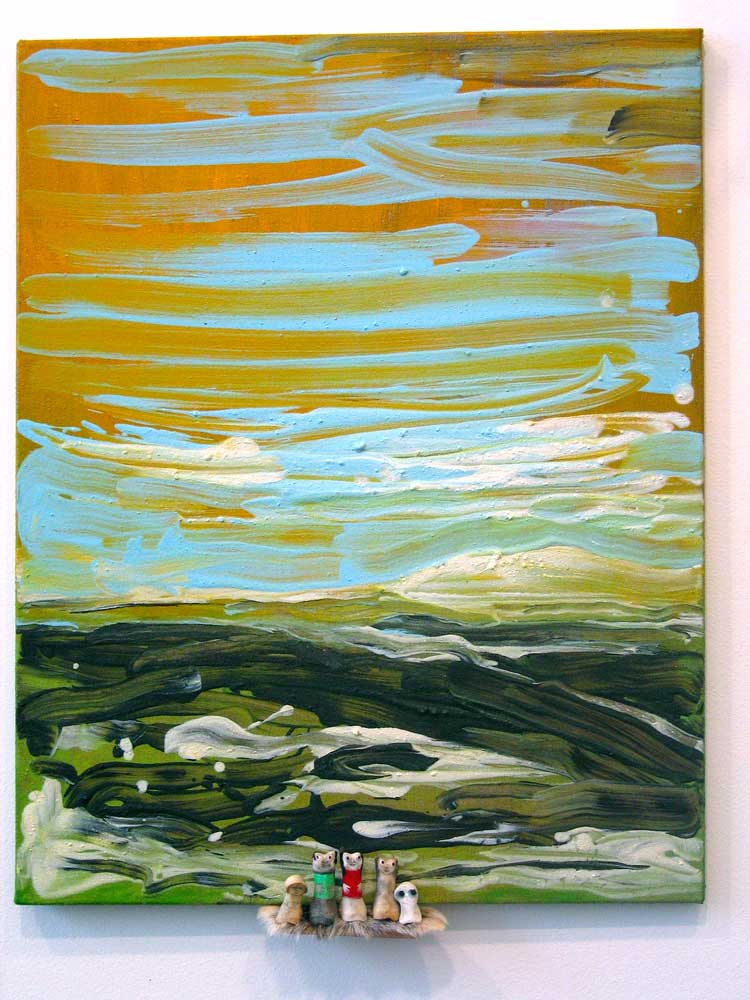
Outi Pieski, Geasi vuordin / Waiting for the Summer, 2007. Photo: Outi Pieski.
These little figures, carved out of reindeer horn, represent the people in that landscape and the continuity of a time-honoured practice of craft, and carving such toys for Sámi infants. Nearby, a glowing tree is painted in loving detail, adorned with tiny bronze circles that catch the light; ribbons are pinned either side of the frame and a small offering sits on a shelf at its base: vintage lace and a traditional felted hat. The presence of such folk decoration and adornments might once have seemed odd or whimsical in a white cube gallery such as Tate St Ives, but here their presence conjures something specific about place, time and practices, informing and enriching Pieski’s themes and aesthetic. This tree represents Pieski’s grandmother, her matrilineal connections to family and land, the lace and hat once hers.
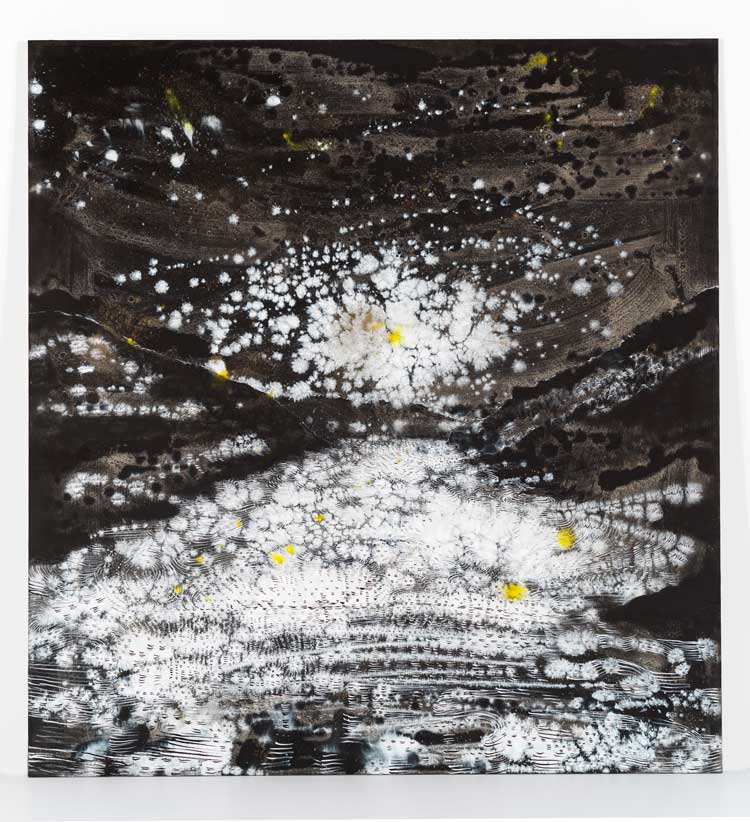
Outi Pieski, Deatnu, máttožan / Deatnu River, Our Ancestor, 2018. © Ari Karttunen / EMMA – Espoo Museum of Modern Art.
A trio of paintings of exquisitely rendered, hyperreal icy landscapes on the far wall are fringed with silky polyester tassels, some draped casually over the top of the painting, extending the glacial tones of blue and white – or a pale and dawn-tinged pink – softly below or within their margins. This series is captioned Top of the Nuvvos Áilegas (2013), and we are informed that the Áilegas Fell in Utsjoki is one of the most sacred places for the Sámi people. Below it runs what the Sámi call the Deatnu (meaning great) River (the Finns call it Teno, the Norwegians know it as Tana).
Sámi artist Pauliina Feodoroff (one of the trio of Sámi artists who occupied the Nordic Pavilion at 2022’s Venice Biennale) writes in the caption: “In the Sámi worldview, the entire world is animated with life. The ethereal is connected to the practical. Deities appear in placenames, and goddesses and mythological creatures are understood to inhabit the landscape … Pieski’s work incorporates this holistic worldview to reflect on the impacts of colonialisation.”
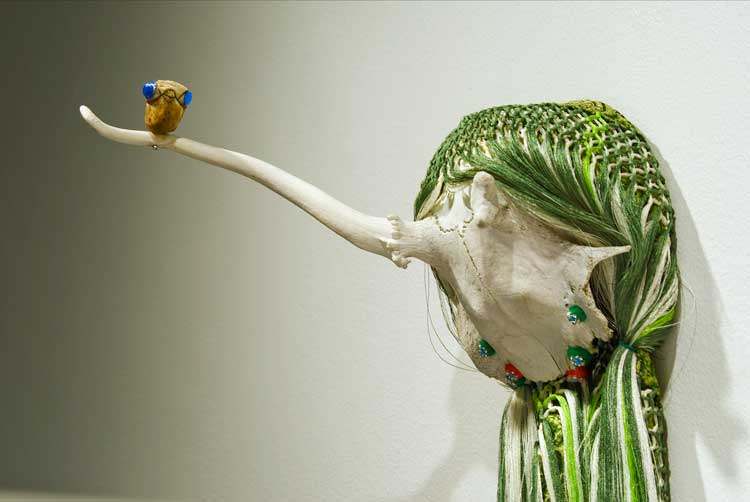
Outi Pieski, Lottelávlunmuorra I / A Bird’s Singing Tree I (detail), 2008 © The artist. Photo: Sámi Museum Siida.
The colonialisation to which Pieski and others are objecting involves not just the seizure of Sámi territories by Russians, Swedes, Finns and Norwegians over the last 100 years, to exploit them for their minerals and wind-farming potential, but the deliberate suppression of traditions - which began with the first Christian missionaries in the 17th century – and the Sámi language. In the first gallery, there is a reindeer skull (Lottelávlunmuorra/A Bird’s Singing Tree, 2008), draped with a shawl and featuring a small model of an owl – an assemblage in which Pieski is evoking a joik, a traditional Sámi song in which tonal sounds are chanted to mimic the sounds of nature, such as rivers and wind. They are sung, the caption tells us, to evoke a person, animal or place. This practice was banned by the Christian missionaries, who were fearful of rituals they didn’t understand and which they assumed involved conjuring up primitive spirits; it is now undergoing a revival. As is the ládjogahpir, a traditional hat that Pieski celebrates in its own dedicated gallery (of which more later). This unusual-shaped hat rises from a close-fitting cap to form a large, rounded horn, supported by a light timber frame and stuffed with animal hair for extra warmth; it is meant to be worn only by women. The missionaries seemingly felt threatened by its clear communication that women have a special role in society, declaring them equal to and different from men.
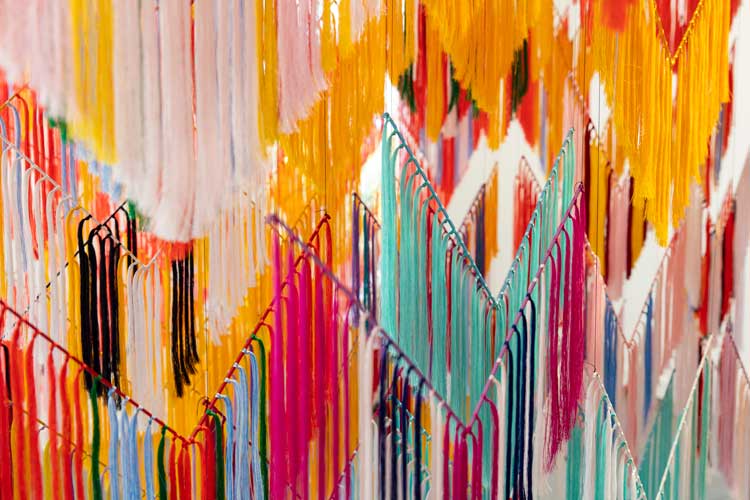
Outi Pieski, Beavvit – Rising Together II, 2021 (detail). © The artists. Photo: Tor Simen Ulstein / Kunstdok.
Beyond the first gallery floats a gorgeous, shimmering shape made from fine polyester threads, dominated by shades of red and orange, created through the traditional knotting techniques with which Sámi women edge their shawls (Beavit/Rising Together II, 2021). Pieski writes in the caption: “Collective craftivism is visible in my art practice. It represents ritual, sacrifice, redress, atonement and the contradictory forces in Sámi societies.” She also describes this knotting as “a matriarchal counterforce to a competitive, individual-centred society”.
Pieski’s work is very much a celebration of these craft traditions and techniques, known as duodji, and groups of Sámi women have helped to create this work and the two knotted, tasselled structures beyond. One is a new work for Tate St Ives, Spell on Me! (2024), assembled by Pieski during a month-long residency at Porthmeor Studios, just behind Tate St Ives. Its colours were inspired by the delicate tones that appear in the sky in that summer period when there is almost no separation between sunset and sunrise. Spell on You! (2020) is a darker assemblage, inspired by the long Nordic winter nights.

Outi Pieski, Guržot ja guovssahat – Spell on You!, 2020. Installation view, 23rd Biennale of Sydney, rīvus, 2022. © Document Photography.
The two works sit at the centre of the largest gallery, surrounded by Pieski’s paintings from the last two decades. Her technique in these paintings is remarkable. Some are representational, appearing to create a recognisable landscape, usually icy or mountainous – though there is always far more going on in and around the surface than mere representation - and others are more abstract, including one in which she seems to conjure the very energy of the sacred mountain Rástegáisa, with whirling, wave-like, dark forms at its centre. Called Iehčanas vuoigatvuohta leat ja lieđđut/Independent Right to Exist and Flourish (2018), here she is referring to Ecuador’s decision in 2008 to rewrite its constitution to enshrine the rights of nature in law.
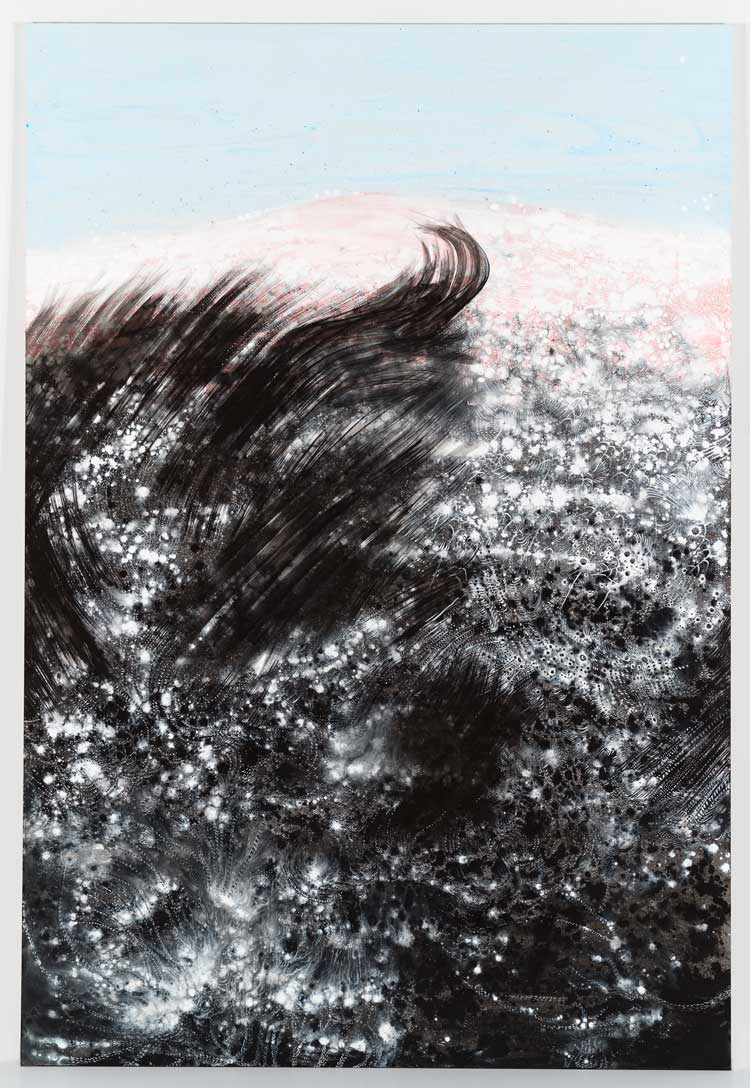
Outi Pieski, Iehčanas vuoigatvuohta leat ja lieđđut / Independent Right to Exist and Flourish, 2018. © Ari Karttunen / EMMA – Espoo Museum of Modern Art.
She also states in the adjacent caption that a Guardians of Nature concept should prevail, allowing a site to be protected by a community that has occupied that region long before colonisers came to claim it. Elsewhere, there is a painting of a tall tree (Suhpiid Luhtte/Close by the Aspens, 2008), from whose wintry leaf canopy a pair of dark eyes peer.
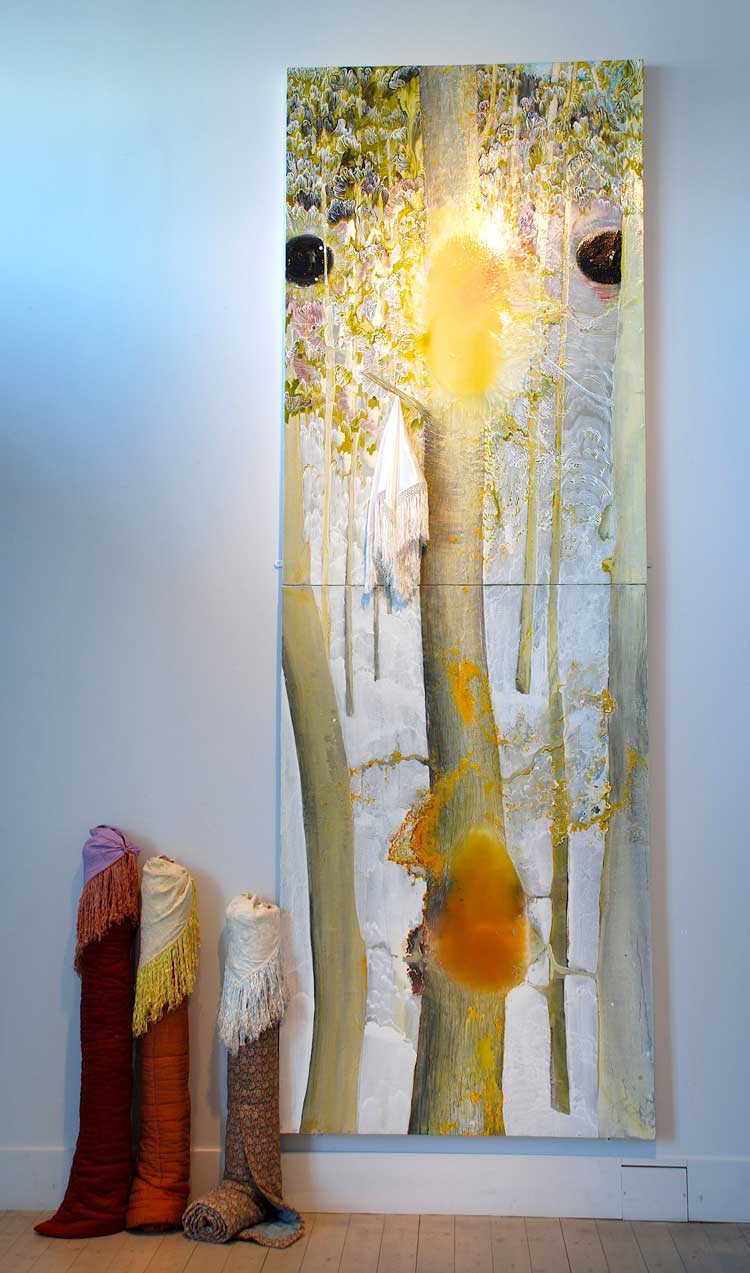
Outi Pieski, Suhpiid luhtte / Close by the Aspens, 2008. Photo: Outi Pieski.
Nearby, a painting of what initially looks like a rugged, wintry landscape, on closer inspection closely resembles reindeer fur – and is indeed inspired by that texture (Rádjajohtin III/Pacing the Borders III, 2014). It is adorned with tiny red tassels like those stitched into traditional reindeer-calf hats to make them more beautiful and strengthen the seams.
-Pic-V-Simpson.jpg)
Outi Pieski, Gurra / Gorge, 2014. Acrylic on canvas, 160 x 120 cm. Photo: Veronica Simpson.
In another painting, ostensibly of a gorge (it is called simply Gurra/Gorge, 2014), the black and inky upper part looks like some kind of dangerous fissure, but in the foreground, Pieski’s technique yields an amazing effect, thanks to a combination of delicate strands and soft blooming dots; they look like mosses, appearing to grow towards you. Yet another, (2009), represents a hill in the Giisavárri area that is said to hide buried treasure. Along the lower part of the acrylic painting, tiny glowing dots, like eyelets appear, which Pieski tells us are intended to represent the spirits that guard this mountain.
,-Pic-V-Simpson.jpg)
Outi Pieski, Čáhppes Giisavárri / Black Fjeld Giisavárri, 2009. Photo: Veronica Simpson.
Tate St Ives director and the show’s curator, Anne Barlow, says: “It’s very important to realise when trying to speak about how Outi deals with landscape, it’s not a classic western perspective where you are representing something: for her, you are transmitting it, it is an action, it is live. You are not one step removed, you are part of it.”
Pieski is based in the Ohcejohka (Utsjoki) area in northern Finland. She graduated from the Academy of Fine Arts in Helsinki in 2000 and has exhibited internationally for more than two decades. She exhibited most recently at the Gothenburg Biennial (2023), Gropius Bau, Berlin (2022), Bonniers Konsthall Stockholm (2022), the Biennale of Sydney (2022), the Gwangju Biennale (2021) and she appeared at the Venice Biennale of 2019. Her work is in the collections of the National Museum, Moderna Museet, Museum of Contemporary Art Kiasma and the Sámi Dáiddamagasiidna – Sámi Art Collections in Norway.
Studio International spoke to Pieski at Tate St Ives, at the opening of her show.
Veronica Simpson: Congratulations on this fascinating and enjoyable show. How does it feel to see the work of decades gathered together here in St Ives?
Outi Pieski: It’s such a privilege for me having an exhibition at Tate St Ives and very special for me to have so many paintings together, and early works that have not been shown much. Then I had the opportunity to work here at the Porthmeor Studios and make this installation.
VS: By this installation, you mean Spell on Me! (2024). Can you talk me through the inspiration for this one as well as your earlier work, Spell on You! (2020).
OP: Guržot ja Guovssat/Spell on You! is a nomadic monument inspired by the gathering of Sámi people. It was handwoven by me together with female duodjars (duodji/craft practitioners) in Finland, Norway and Sweden. The tassels represent a healing flock that can strengthen communities from intergenerational traumas caused by colonialism and help individuals wounded in our common struggle. We are creating this kind of experience of being in one specific place – we all have that kind of space that is really important. I want to give the visitor a bodily experience of what it is to be connected with that space.
VS: By space do you mean directly responding to a particular landscape, or is it more to do with an aura, or a sense of elevation that we can experience in a place?
OP: It’s more about the experience and feelings than about picturing the specific landscape. I call these tassel installations three-dimensional paintings. They are made in the Sámi crafting tradition for making things like the tassels on the Sámi shawl. It’s the same fabric and the same technique. I like to follow the traditional techniques. It’s a simple act, but we say a prayer when we are making the knots, and it is something the women do together. The Sámi have a holistic world view in which everything is connected, and spirituality is part of the everyday … You are connected to spirituality by practical acts. It’s always about acting and working and doing something. It always comes from the land, and it’s made for the land.
-and-Spell-on-Me!-(2024)-at-Tate-St-Ives,-2024-Tate-(Oliver-Cowling)_01.jpg)
Outi Pieski, installation view, Tate St Ives, 2024. Photo: © Tate/Oliver Cowling.
VS: I like the way the work is experienced in the show. You move from the early landscapes and shawl paintings to this large room framed by your paintings and, in the centre here, it feels as if the shawls have lifted off the paintings to create their own landscape.
OP: Yes, I find this exhibition architecture really clever because the paintings are surrounding you with the Sámi landscape and then in the middle you can … go into that world.
VS: Tell me a little about your painting technique. Some of them seem like literal landscapes, but others are more abstract and more emotional. They all work on several levels.
OP: The paintings are a tool for me to hold on to the connection with the land and remember those specific moments when you are connecting to it. And I want to repeat that kind of experience, make it happen again. I used a lot of this liquid paint material. I find the way the liquid creates its own image is a very important part.
I am very much connected to the world by details. Like the Sámi relationship to land, it’s about the details, even though you can see very far away, long distances, but the actual connection comes from closely observing the details, I think. For me, the painting is a kind of writing, and it’s this kind of auto-writing technique, which I don’t need to control – it’s almost making itself.
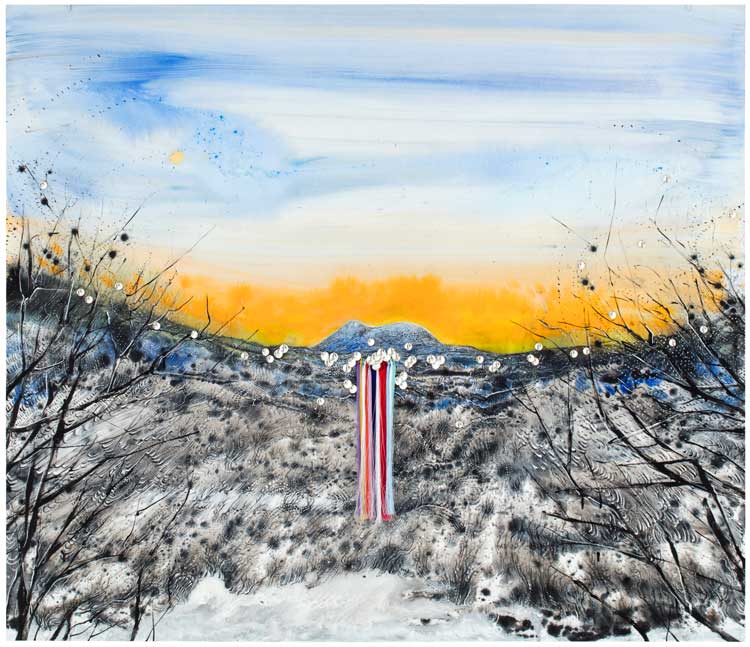
Outi Pieski, Rástegáisa lágalaš riektesubjeaktan II / Sacred Mountain Rástegáisa as a Legal Person II, 2018. Photo: Jussi Tiainen.
VS: What do you feel your work and these landscapes communicate to this very particular landscape of St Ives? At its most wintry, it can be bleak and grey, as I imagine the Sápmi land is, but seascapes are transformed with the slightest shift in light, as I would imagine the Arctic landscapes are.
OP: Of course, I can see there are some similarities to my home area, like, for example, thinking about the Cornish history and what has happened to Cornish language, and I feel privileged I am able to speak my language, the Sámi language, and it is still alive. I think I can only work in relationship to my homeland. And bring up those connections that I have there. It takes a lot of time to create a relationship to one space and place.
VS: St Ives is a town that evolved over thousands of years in relationship to the sea, with fishing for sustenance and then trade being the priority, a working relationship to the land. Now, sadly, it mainly seems to exist as a place for people to come and consume the landscape for leisure, as tourists, celebrating its quaintness and “wildness”.
OP: Sámi land is often pictured as a wilderness area, like a no man’s land, but that is a very political way to view the land because then it justifies the colonial approach - taking the opportunity to do all kinds of things, such as industrial exploitation. When you walk here, it’s not wilderness, it’s deeply affected by humans living together with this environment.
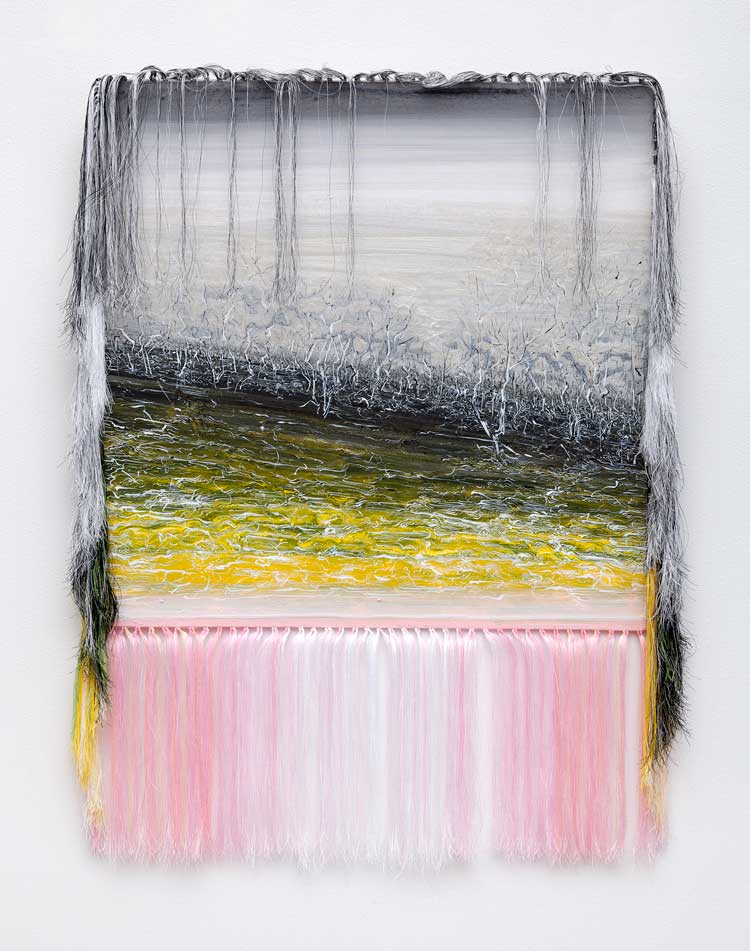
Outi Pieski, Silbajohka / Silver River, 2014. Acrylic on canvas, thread, 85 x 60 cm. Photo: Jussi Tiainen.
VS: You have exhibited all over the world, at the Sydney Biennial and in Shangzhou, for example. Is it important that your work dialogues with something ancient and contemporary in those places? How can you ensure that your work is seen as part of a vital cultural conversation and not some kind of ethnographic event?
OP: Well, at the moment … the contemporary art museums in general are spaces for dreaming and experimenting, which is extremely important, and also to open up all kinds of conversations. I think the more you can express your personal relationship with the land, the better others can also understand that from their own point of view. We all are sharing the same relationship with the land. The indigenous peoples are forced to play a significant role in climate crisis issues because their lands are where the ecosystems are still intact. But it’s so important to point out that these are questions that everyone needs to work with: everyone needs to work out their own relationship with the land. We all have that possibility and responsibility.
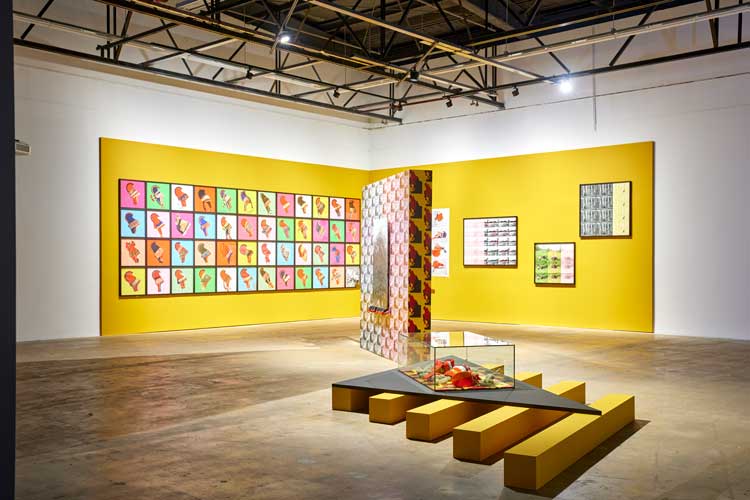
Outi Pieski, Rematriation of a Ládjogahpir / Return to Máttaráhkká, 2019. Installation view courtesy of Minds Rising, Spirits Tuning, The 13th Gwangju Biennale, Photo: Sang Tae Kim.
VS: Tell me about the work you have done with Eeva-Kristiina Nylander on the ládjogahpir, the horned hats, which we see in their own separate display here.
OP: This is part of the work I was doing with Eeva-Kristiina for a research project investigating the mind and body of Sámi women and their history and the colonial history. This one particular museum object, the ládjogahpir hat, was diminished by the Christian missionaries, who said that the devil lived inside the horn. As a visual artist, I’m interested in how you can read the concrete form and the change in that form, you can read the colonial history and also how the Sámi society was more equal – both between genders and also humans and nature. But when the colonialism came, the patriarchal culture made this society unbalanced.
It was a political act to make the Sámi society more unbalanced and establish gender hierarchies because we don’t live with hierarchies in Sámi history: everything is on the same level. We live in a harsh Arctic environment, every individual, every animal, is so important and has his own role.
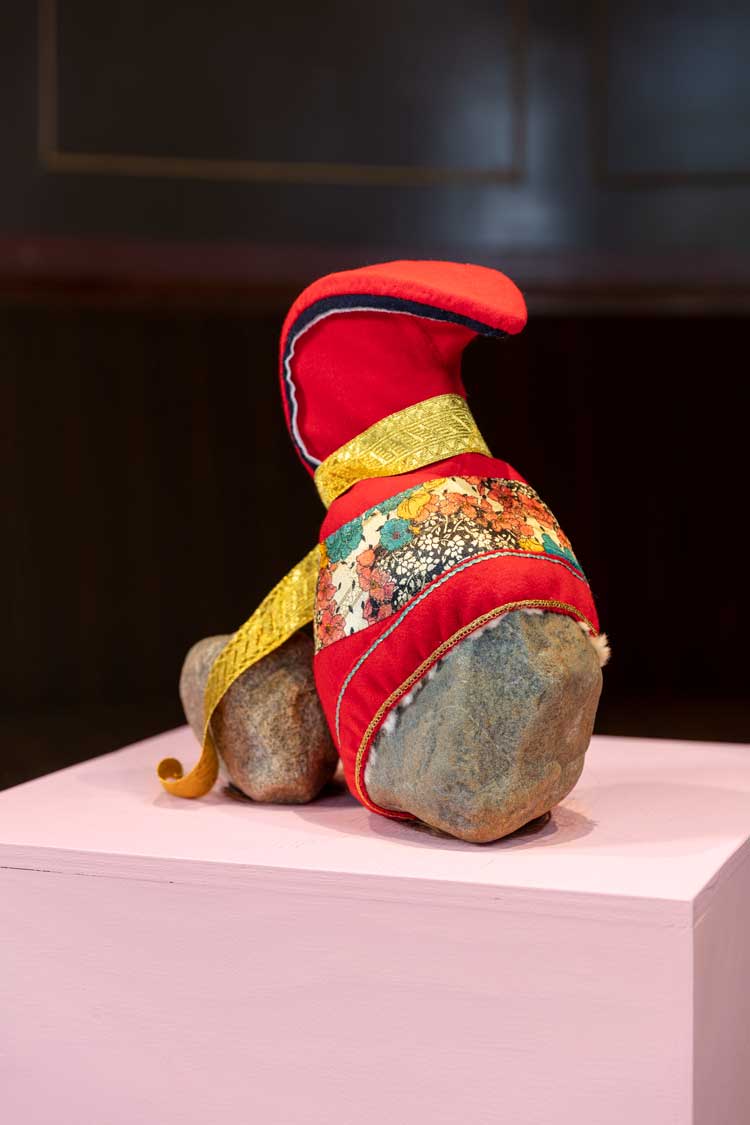
Outi Pieski, Lossa máttaráhkku / The Heavy Weight of the Foremother, 2021. © The artist. Photo: Tor Simen Ulstein / Kunstdok.
So, doing this project we have been investigating the old ládjogahpir hats that are in European museums. I have learned to make the ládjogahpir hats again and we have had workshops where we have made the hats with other Sámi women, and that kind of crafting has been empowering and important to bring opportunities to talk about difficult issues. This project is bringing out the importance of repatriation - it is so important to get the ancestral belongings back to the home areas. And we have used the term “rematriation”, to signifiy reconnecting and relearning and remembering, and healing together with the belongings. This ládjogahpir hat has become a new symbol for decolonial feminism and it has become really popular … Because we wanted ládjogahpir to become really popular, we have this pop art-style work - I called this The 47 Most Wanted Foremothers (2019), inspired by Andy Warhol’s (1946) work The 13 Most Wanted Men. These hats are like prisoners in the museum collections and when they come back, they become like a flock of very powerful foremothers bringing the Sámi powers back home.
VS: You have been very vocal about these precious artefacts being returned to Sámi museums.
OP: There are several Sámi museums. One in Finland, the Sámi Museum Siida, and another one in Sweden, the Ájtte Museum. In Norway, there are several smaller Sámi museums, and the repatriation has already started. The folk museum in Norway, Norsk Folkemuseum, has given half of its collection to the Sámi museums, and Finnish museums have given their whole collection to Sámi Museum Siida.
VS: So, this work has already had an impact?
OP: There is also one hat in the British Museum collection, which we would have liked to have in this exhibition. Unfortunately, we did not get it. They said we hadn’t requested it in time: we asked nine months beforehand when they say it should have been 12 months.
• Outi Pieski is at Tate St Ives, Cornwall, until 6 May 2024.